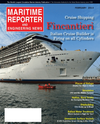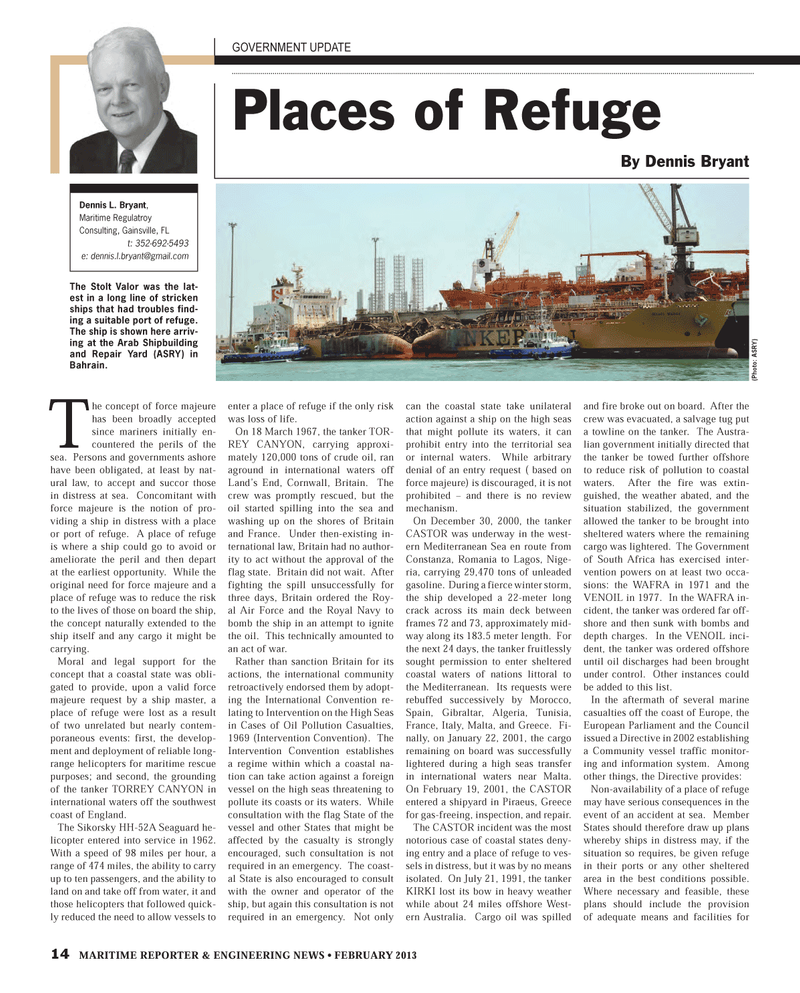
Page 14: of Maritime Reporter Magazine (February 2013)
Cruise & Passenger Vessel
Read this page in Pdf, Flash or Html5 edition of February 2013 Maritime Reporter Magazine
14 MARITIME REPORTER & ENGINEERING NEWS ? FEBRUARY 2013 GOVERNMENT UPDATE Places of RefugeBy Dennis Bryant Dennis L. Bryant, Maritime Regulatroy Consulting, Gainsville, FLt: 352-692-5493e: [email protected] concept of force majeure has been broadly accepted since mariners initially en-countered the perils of the sea. Persons and governments ashore have been obligated, at least by nat-ural law, to accept and succor those in distress at sea. Concomitant with force majeure is the notion of pro-viding a ship in distress with a place or port of refuge. A place of refuge is where a ship could go to avoid or ameliorate the peril and then depart at the earliest opportunity. While the original need for force majeure and a place of refuge was to reduce the risk to the lives of those on board the ship, the concept naturally extended to the ship itself and any cargo it might be carrying.Moral and legal support for the concept that a coastal state was obli-gated to provide, upon a valid force majeure request by a ship master, a place of refuge were lost as a result of two unrelated but nearly contem-poraneous events: first, the develop-ment and deployment of reliable long-range helicopters for maritime rescue purposes; and second, the grounding of the tanker TORREY CANYON in international waters off the southwest coast of England. The Sikorsky HH-52A Seaguard he- licopter entered into service in 1962. With a speed of 98 miles per hour, a range of 474 miles, the ability to carry up to ten passengers, and the ability to land on and take off from water, it and those helicopters that followed quick-ly reduced the need to allow vessels to enter a place of refuge if the only risk was loss of life. On 18 March 1967, the tanker TOR- REY CANYON, carrying approxi- mately 120,000 tons of crude oil, ran aground in international waters off Land?s End, Cornwall, Britain. The crew was promptly rescued, but the oil started spilling into the sea and washing up on the shores of Britain and France. Under then-existing in-ternational law, Britain had no author- ity to act without the approval of the flag state. Britain did not wait. After fighting the spill unsuccessfully for three days, Britain ordered the Roy-al Air Force and the Royal Navy to bomb the ship in an attempt to ignite the oil. This technically amounted to an act of war. Rather than sanction Britain for its actions, the international community retroactively endorsed them by adopt-ing the International Convention re-lating to Intervention on the High Seas in Cases of Oil Pollution Casualties, 1969 (Intervention Convention). The Intervention Convention establishes a regime within which a coastal na-tion can take action against a foreign vessel on the high seas threatening to pollute its coasts or its waters. While consultation with the flag State of the vessel and other States that might be affected by the casualty is strongly encouraged, such consultation is not required in an emergency. The coast- al State is also encouraged to consult with the owner and operator of the ship, but again this consultation is not required in an emergency. Not only can the coastal state take unilateral action against a ship on the high seas that might pollute its waters, it can prohibit entry into the territorial sea or internal waters. While arbitrary denial of an entry request ( based on force majeure) is discouraged, it is not prohibited ? and there is no review mechanism. On December 30, 2000, the tanker CASTOR was underway in the west- ern Mediterranean Sea en route from Constanza, Romania to Lagos, Nige-ria, carrying 29,470 tons of unleaded gasoline. During a fierce winter storm, the ship developed a 22-meter long crack across its main deck between frames 72 and 73, approximately mid-way along its 183.5 meter length. For the next 24 days, the tanker fruitlessly sought permission to enter sheltered coastal waters of nations littoral to the Mediterranean. Its requests were rebuffed successively by Morocco, Spain, Gibraltar, Algeria, Tunisia, France, Italy, Malta, and Greece. Fi- nally, on January 22, 2001, the cargo remaining on board was successfully lightered during a high seas transfer in international waters near Malta. On February 19, 2001, the CASTOR entered a shipyard in Piraeus, Greece for gas-freeing, inspection, and repair. The CASTOR incident was the most notorious case of coastal states deny-ing entry and a place of refuge to ves-sels in distress, but it was by no means isolated. On July 21, 1991, the tanker KIRKI lost its bow in heavy weather while about 24 miles offshore West- ern Australia. Cargo oil was spilled and fire broke out on board. After the crew was evacuated, a salvage tug put a towline on the tanker. The Austra- lian government initially directed that the tanker be towed further offshore to reduce risk of pollution to coastal waters. After the fire was extin- guished, the weather abated, and the situation stabilized, the government allowed the tanker to be brought into sheltered waters where the remaining cargo was lightered. The Government of South Africa has exercised inter- vention powers on at least two occa-sions: the WAFRA in 1971 and the VENOIL in 1977. In the WAFRA in- cident, the tanker was ordered far off- shore and then sunk with bombs and depth charges. In the VENOIL inci- dent, the tanker was ordered offshore until oil discharges had been brought under control. Other instances could be added to this list.In the aftermath of several marine casualties off the coast of Europe, the European Parliament and the Council issued a Directive in 2002 establishing a Community vessel traffic monitor- ing and information system. Among other things, the Directive provides:Non-availability of a place of refuge may have serious consequences in the event of an accident at sea. Member States should therefore draw up plans whereby ships in distress may, if the situation so requires, be given refuge in their ports or any other sheltered area in the best conditions possible. Where necessary and feasible, these plans should include the provision of adequate means and facilities for The Stolt Valor was the lat- est in a long line of stricken ships that had troubles find- ing a suitable port of refuge. The ship is shown here arriv- ing at the Arab Shipbuilding and Repair Yard (ASRY) in Bahrain.(Photo: ASRY) MR #2 (10-17).indd 14MR #2 (10-17).indd 142/3/2013 2:08:00 PM2/3/2013 2:08:00 PM

 13
13

 15
15
